With the emergence of Covid-19, the world applauds its frontline medical staff, whose life-saving struggles usually go unseen. On Cambodia's massive Tonlé Sap Lake, a team of 'floating doctors' quietly cares for some of the most vulnerable people in Asia.
THE TONLÉ SAP LAKE in northern Cambodia is the largest body of freshwater in Southeast Asia. During rainy season from May to October, the lake swells to about six times its dry-season size, extending over 16,000 square kilometres — an area 20 times the size of New York City.
The Tonlé Sap is also one of the planet’s most productive inland fisheries. More than a million people are dependent on the lake for their livelihood, and about 100,000 live in its immediate vicinity.
While many dwell in stilted villages on the lake’s flood plain, the poorest huddle in floating communities on the lake itself, sometimes hours from dry land. Their homes are often fragile, rain-leaking shacks cobbled together from woven reeds, scraps of plywood, tin sheet and tarpaulin, all lashed to wooden or bamboo rafts kept afloat on air-filled oil drums.
They are among the most isolated communities in Cambodia, the majority relying on subsistence fishing for their survival.
According to the World Health Organization, Cambodia has just 1.7 doctors for every 10,000 people (both the US and the UK have about 26; Norway has 46). For floating communities on the lake, the number of accessible doctors had long been zero.
American Jon Morgan first became troubled by the lack of healthcare on Tonlé Sap in the 1990s, having recently completed his masters in public health at the University of Hawaii.
Morgan, who went on to co-found the Angkor Hospital for Children in the nearby Cambodian city of Siem Reap, noted that lake dwellers’ poverty, poor nutrition and hygiene, and the high fees for medical treatment only available far from home all combined to whip up a perfect storm of preventable diseases and treatable injuries that could ruin or end lives.
“I thought, my God, this is a nightmare,” says Morgan, 67. “Somebody has to do something.”
His solution was The Lake Clinic – Cambodia (going, rather neatly, by the acronym TLC), which became a reality in 2007, growing in scope and ambition ever since. Through the years, TLC has provided more than 240,000 individual medical services to those living on the Tonlé Sap.
Today, TLC operates five “floating clinics” — four on the lake and one on the adjoining Stung Sen River — catering to more than 10,000 people in nine of the most under-served floating communities.
With five doctors, two nurses, four midwives, a dental nurse and support staff, and funded purely by private donations, TLC’s two homegrown medical teams each make a three-day trip into the field every week. They live and work in the offshore facilities to provide free medical care and health education to the most forgotten people in one of the Asia’s poorest countries. ◉
Shorter versions of this photo essay ran in Hong Kong's Post Magazine (download PDF) and in The Providence Journal (in colour) in the US in 2020. Learn more about The Lake Clinic's work here.
SHARE

TLC FOUNDER JON MORGAN says there are at least 50 floating communities on the lake, jointly home to tens of thousands of people. Most eke out a living through fishing. The average family income is about 10,000 Riel (US$2.5) a day. Photos: Gary Jones

Midwives Ky Kolyan, Chan Soda and Chhuom Sary and a medical team cast off from TLC’s home port at Kampong Khleang. Their wooden boat heads for the floating clinic at Peam Bang, 50km to the south and home to about 200 families. The team’s journey to work will take more than four hours. They stay on the lake for three days each week, sleeping under mosquito nets on foldout camp beds in the floating clinics.
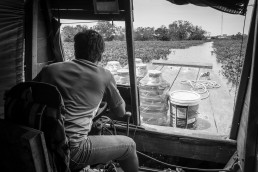
The boat, one of TLC’s fleet of six, navigates a channel through dense beds of water hyacinth. In high-water season, the lake has an average depth of about 10m. During dry season, that falls to less than a metre, and smaller, shallow-draft boats must be deployed.
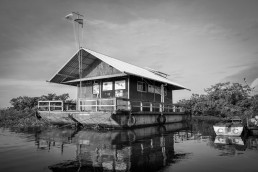
TLC’s Peam Bang clinic sits on a pontoon anchored to the lake floor. Water depth at this location rises to about eight metres in wet season, the ‘bushes’ here actually being the tops of submerged trees.

TLC medical director Dr Hun Thourida unloads the boat. She has worked with TLC since 2012, after graduating from the respected St Petersburg II Mechnikov State Medical Academy in Russia. ‘Doctor Rida’ chose to return to her home country to help the needy. She is fluent in Khmer, English and Russian.
Chhuon Sary, supported by Doctor Rida and clinical coordinator Uk Savann, gets the Peam Bang clinic scrubbed and ready for action. TLC currently operates five floating clinics serving nine of the most isolated lake communities. The most accessible is 30km from port; the furthest is more than 100km away.
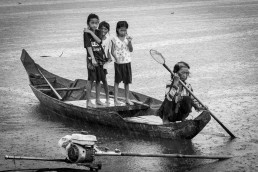
Three girls and their grandmother are caught in a shower while heading for the clinic.

On a busy day, a TLC clinic might welcome 100 patients. Most are women — mothers and grandmothers — with children in tow, and a smattering of older men. Unless seriously ill or injured, men of working age will be too busy fishing and tending nets to see a doctor. ‘These people live by the day,’ says Dr Hun Thourida. ‘What they catch is all they have.’
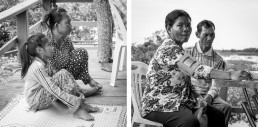
Common ailments on the lake include malnutrition and measles in the young, diarrhoea caused by drinking dirty water (a major cause of childhood death), infected wounds (often from the propellers of outboard motors), tuberculosis, fungal conditions, malaria, dengue fever, complications from diabetes, respiratory infections, severe tooth decay and burns, as well as hypertension and arthritis in older patients.
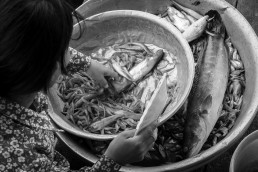
A woman sorts through her catch while waiting to see a doctor. Catches have fallen drastically on the Tonlé Sap over the past decade due to overfishing, pollution and hydropower-dam building upstream — most notably in Laos and China, on the Mekong that feeds the lake via its tributary the Tonlé Sap River.
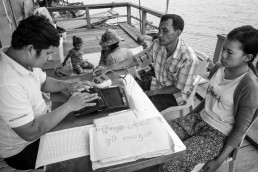
Nurse Suon Piseth checks the blood pressure of all patients on their arrival at the clinic.

TLC measures and weighs lake children under the age of five every six months, charting their growth. Cambodia as a whole has a 32 per cent malnutrition rate, according to TLC data, rising to 59 per cent on the lake. Malnutrition is especially common among youngsters, with fish caught or farmed by their families usually being sold.

Diets therefore revolve around rice, chilli and salt, lacking in protein, fat and micronutrients. ‘Two-thirds of the kids on the lake are stunted due to chronic malnutrition,’ says Jon Morgan. ‘To their families, fish has more value as a commodity to sell than as nutrition.’
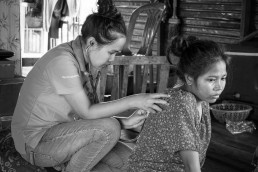
Doctor Rida pays a house call by boat to a woman unable to reach the clinic. The doctor has been treating the 28-year-old for Pott’s disease — tuberculosis of the spine — that could have resulted in paralysis. The woman lives with her small daughter, her mother, who has Parkinson’s disease, her father, who lost a leg to gangrene, her sister, who also has TB, and her sister’s husband — the family’s sole breadwinner. The woman’s husband disappeared when she became unwell.


A mother takes her sick daughter’s temperature with a digital thermometer; Chhuom Sary vaccinates a toddler against diphtheria, tetanus and whooping cough.
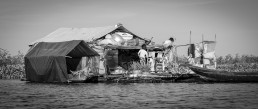
Children play outside a family’s floating home. According to the most recent Cambodia Demographic and Health Survey, one in every 29 Cambodian children dies before his or her fifth birthday, with the mortality rate ‘markedly higher in rural areas’, or one in every 19 under-fives. On the lake, young death comes even more readily. Dr Hun Thourida says lake families often have as many as 10 children, with many not surviving to adulthood. ‘Some drown between the age when they start to crawl and when they learn to swim,’ she says.
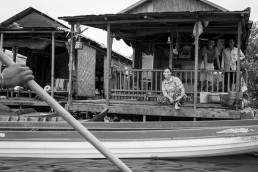
Dr Hun Thourida says many lake dwellers have no opportunity to live on land, with many effectively stateless, their births never having been registered. Such people cannot own property, get a job and pay tax, obtain a driver’s licence or open a bank account. ‘Fishing is all they know. Because of poverty they are stuck,’ she says. ‘They were born on water and they will die on water.’

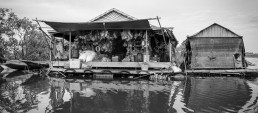
Everything is designed to float at Peam Bang — including homes, mechanics’ workshops, livestock pens and chicken coops. Some lake communities have floating schools and churches, while convenience stores sell instant noodles, potato chips, candy and sugary drinks to those who can afford them. Tooth decay is increasingly a problem due to poor oral hygiene.
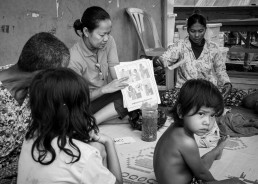
Ky Kolyan explains the dangers of consuming lake water. TLC encourages the use of bio-sand filters. ‘We have to tell them, the water might look clear, but you poop in the water and you pee in the water, so it’s not good to drink,’ says clinical coordinator Uk Savann.

TLC has established a ‘Mother’s Club’ in each community, with counselling on antenatal care, hygiene, birth spacing and contraception. The goal is to decrease maternal and infant mortality rates.
A poster at the Peam Bang clinic instructs on how to build and maintain floating vegetable gardens. Crops include water spinach, cabbage, lemongrass, spring onions, tomatoes and eggplant. Families can sell any surplus.


